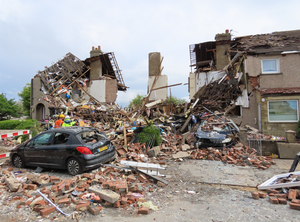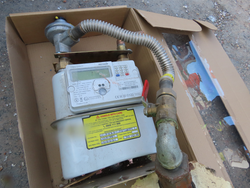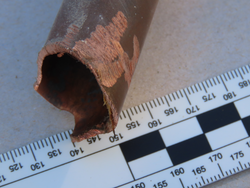When the worst happens
In the Autumn 2023 edition of Gu, Steve Critchlow of HSE and Dr Gary Tomlin of DNV provided an insight into the work of specialist investigators who provide the answers when industry and society asks “what went wrong?”
With around 23 million domestic gas connections, and 56 million people exposed to gas in their homes, the industry has a good safety record. But serious incidents do occur, and when they do, they are often huge news both locally and nationally.
Gas investigations are important work meaning that public faith in the safety of the gas industry is vital, and so when incidents happen, we need to know why.
Are there lessons the industry needs to learn? Will new standards and regulations be required, or public safety information need to be issued?
And if a person or company has caused the incident through actions or omissions which they should have known to be reckless then evidence must be gathered to bring them to account.

At around 2.40 am on 16 May 2021, the emergency services were called to reports of an explosion on Mallowdale Avenue, in Heysham.
They found two houses destroyed and serious structural damage to a third. Debris was spread far and wide and a large number of other houses had damage to their roofs and windows.
Sadly, it turned out that two-year-old George Hinds had lost his young life in number 18, the end property of the three most damaged houses.
The fire service notified the regional gas distribution network Cadent, and their operatives quickly attended site.
The Gas Safety (Management) Regulations (GSMR) place a duty upon the gas networks to attend reported escapes of gas and to stop the gas from leaking.
Clearly, this is an extremely important duty. The same regulations also place a number of other very important duties upon the network following an explosion.
They must perform an investigation as to why and where the gas was released, and they must notify HSE before that investigation commences. This is because in many cases the HSE will want to perform their own investigation. Regulation 16 of GSMR also requires that the person who carries out the investigation is “competent”.
Investigation of gas explosions is incredibly niche. Clearly the investigator needs a detailed knowledge of how a gas explosion manifests and the evidence required to prove a gas explosion has occurred and where the gas came from.
They also need a detailed knowledge of both downstream and upstream engineering as well as knowledge of other types of explosions so these can be ruled out. Very few individuals will meet this criteria. For this reason, the gas networks employed DNV to be their competent investigator. Steve Critchlow fulfilled this role for HSE.
DNV was called by Cadent on the day of the explosion and attended the same day, and HSE requested Steve Critchlow attend also. DNV started work at site testing the gas network and service pipes in the area.
In such a serious fatal incident the police will lead the investigation (in ‘primacy’) and therefore be in charge of the scene and investigation decisions.
It’s highly unlikely that the attending police, or fire service, will ever have dealt with such a large explosion incident and this was the case at Heysham.
The police locked down the area as a crime scene and this meant access to relevant emergency control valves (ECV) was prohibited. This of course meant DNV and the network could not complete testing of the service pipes, and certainly could not make any measurements downstream.
The first duty was to meet with the police at a commander meeting in Lancaster Police Station. During this meeting, the police shared intelligence about what was known.
It was stated that the occupants of the centre property (number 20) were known to the police, and that it had been reported to them that a local person had “bypassed” the meter.
The types of evidence required for the investigation and the tests required to perform it were explained. Part of this discussion was to ascertain who the network and DNV were, and what their roles were. The police wanted to know our qualifications and experience and our independence.
Eventually, we were able to form a close working relationship between HSE, the police, the fire service, and DNV and by working together the investigation began. Detailed examinations and photography were made of the pattern of structural damage and the distribution of materials.
This vital stage gives an indication as to whether ignition of an accumulation of gas could be responsible, and if so, how much and where the gas was prior to ignition.
We felt that it was likely gas had been in the upstairs of the middle property number 18 because distribution of materials from upstairs was far greater than that from downstairs.
The extent of damage and distribution would, if this was a gas explosion, indicate gas being dispersed through several rooms, and concentrations of gas in air around the stoichiometric ratio.
A key stage was discovering the location of the gas meter in number 20. This had to be dealt with forensically, with both of us wearing disposable masks, gloves and overalls so there was no DNA contamination.

The gas meter we recovered is shown here. No bypass was fitted to the meter, although you may notice in the photo that the meter was dented underneath in contrast to the meter bracket (indicating the damage was not resulting from the incident) and PTFE tape was fitted to the meter connection threads.
A registered gas engineer working at the site a few months prior for the landlord provided a photo of the meter where no PTFE was present.
Therefore, we knew someone had been inside the meter recently. We also managed to create access to the meter position in number 18, and with both ECVs now shut we were able to complete testing of the main and services.
This proved that the network was gas tight, and therefore at that point Cadent was able to tell gas users the incident was not caused by faults with the network. Despite this, Cadent engineers retained an important role by visiting homes in the area to perform downstream testing to reassure locals.
Downstream examination was made very difficult by the unstable condition of the buildings. The fire service provided lookouts and set up lasers to monitor the structure for movement.
With that measure in place, we started examining the debris. A gas explosion will cause thermal scorching of susceptible materials such as oil-based paints and light plastics.
The location of such scorching helps tell us where the gas was (and was not). For example, scorching at low level might indicate a heavier than air gas, whereas scorching exclusively above, say, the worktop might indicate a release location of a lighter than air gas at cooker hob level.
The way glass breaks in an explosion can give an investigator an indication of the way it was pressure loaded, and hence whether it is consistent with a natural gas incident. Similarly, if construction materials are found splintered and shattered it can indicate a fuel with a much higher flame speed than gas.
As the HSE and DNV progressed with the investigation, into the incident properties numerous scorched items were found that would have been located on the first floor of the middle property, number 20.
We weren’t finding any such materials from number 18, George’s house. A grey carpet was in the hallway and stairway of number 18. We noted scorching of it on the landing area and partway down the stairs, but no scorching lower down.
This scorching pattern was consistent with gas ignition on the first floor, a conclusion which matched with the pattern of structural damage.
In the hallway of 20, we found a number of short lengths of copper which had been roughly cut or twisted and stacked together. We couldn’t be immediately certain of the meaning of this, but we began to consider that somebody might have been removing copper from the house.
In such investigations there is always a risk that by moving materials with powered machines important evidence is damaged and lost.
It’s therefore important to be mindful of this. A gas tightness test would be performed as soon as we could get access to a suitable position, and if a tight result was measured, we would seek to release the test air from the end of the installation to prove it was all under pressure during the test.
In this case we could not achieve test pressure on the installation in number 18; a result consistent with an open end existing on the gas installation.
We then chose to blow test smoke into the installation which allowed us to visually locate the first leak site. Steve reached into the debris pile and removed a short section of pipe containing the open end that smoke came from.

It was visually apparent to us that the pipe looked like it had been cut by an abrasive wheel, such as would be found on an angle grinder.
This open-end is shown here. This was passed to the police for laboratory analysis by a metallurgist to confirm the method of cutting.
The landing area of number 20 proved very important evidentially. We found a number of other gas installation pipes cut in a similar manner. We also found the grey carpet scorched on its underside, indicating it had been rolled back prior to ignition.
We found numerous cuts to the floorboards and some of these showed scorching on the underside. As we progressed, we also found a small angle grinder in number 20.
The police would subsequently examine the wheel on this for traces of copper. At this stage, we now had a very clear idea of what had caused the incident; the cutting of gas pipes inside number 20 on the first floor.
The existence of numerous cuts and stacked copper pipe sections indicated the cuts had been a deliberate act. However, it remained vital to examine the rest of the three houses to rule out other causes. Ultimately, number 22 was found to be gas tight. A small leak existed in the kitchen of George’s house at number 18 however, this was too small and in the wrong location to have caused the incident and so could be ruled out.
George’s family had requested the investigators try and find a soft toy that had been his favourite. Such requests remind us of the very human tragedy of such events, and while looking for the toy was akin to the proverbial search for a needle in a haystack everyone involved was very pleased when we did find the toy.
Investigation at site concluded five days after the explosion. A notable feature of this site was the incredible teamwork between all parties without which it surely would not have been the success it was.
In such investigations we will produce calculations of gas flow rate and produce estimations of the time taken to reach the gas concentration that had existed.
In this case we decided it would be helpful to acquire data from the smart gas meter. If data was available, detailed and reliable, it could show exactly when the leak was created. With the assistance of the meter manufacture Secure in Southampton, data was downloaded. Unfortunately, this appeared to show no gas had been used for almost two months.
This was a problem as, in effect, it showed the incident could not have been a gas explosion. We needed an explanation.
A test flow was run through the meter and data was downloaded again, which proved the meter wasn’t recording gas flow. The gas meter was forensically opened, and we found the internals had been forcefully smashed so that flowing gas could not be measured.
Now we knew why someone had been in the meter. Subsequent live gas testing was performed at the DNV Spadeadam site through the meter and downstream pipework, which established the volume of the large gas leak that had existed prior to the incident.
This allowed accurate calculation of the time the leak was created, which in turn allowed the police to establish who was in the house at the time. Lancashire Police remained in regular communication with us throughout their investigation, and when questions arose, we could deal with these in our written reports. The police told us that the occupants of number 20, where the gas pipe had been cut, were extremely non-cooperative.
However, after the written reports landed with the police and the weight of the evidence was presented to the defence, the occupant of number 20, Darren Greenham, changed his plea to guilty.

Greenham admitted a manslaughter charge in August 2022, six months after he first pleaded not guilty and just weeks before a trial was due to begin.
A co-defendant, Paul Marsh, was accused of damaging the gas meter in Greenham’s home to cut bills.
He died before he could be brought to justice. Greenham later accepted that he had cut the copper pipes in his property, intending to sell them for scrap. Greenham was sentenced to 15 years in prison for the manslaughter of George Hinds.
He was also given one month concurrent for theft of gas and damage to a gas meter. Joanna White, Senior Crown Prosecutor with CPS North West said: “This was a tragic case where a young boy lost his life through the reckless and dangerous actions of Darren Greenham, who cut the pipes for financial gain.”
Such investigations are not only technically difficult but can be extremely emotional experiences for those working on them. Establishing the causes of these incidents is important not just for industry but for those affected as well.
Every incident is different, with different challenges, but experienced and qualified specialist investigators working with the support of industry and emergency services can get to the truth and ensure lessons are learned.
Read more stories from this issue of Gu here.
